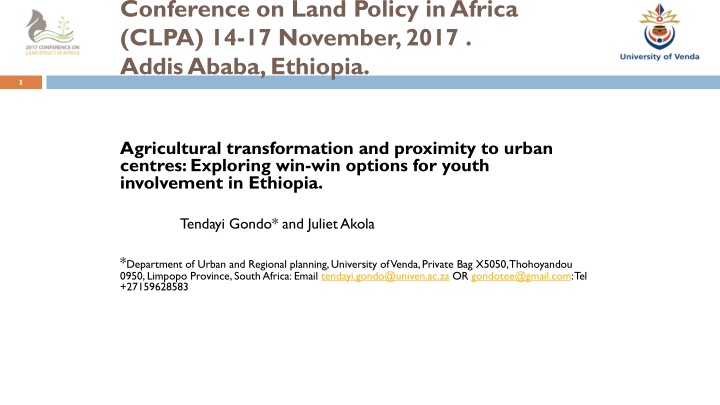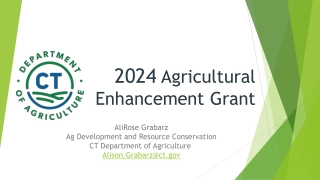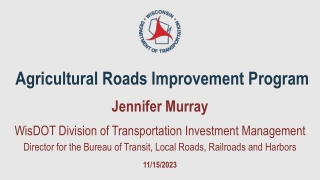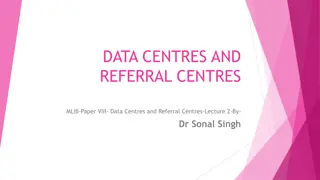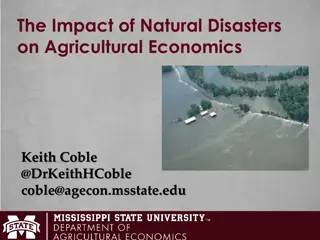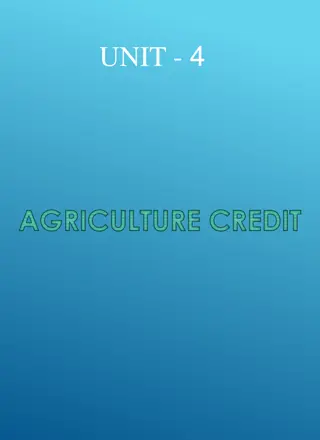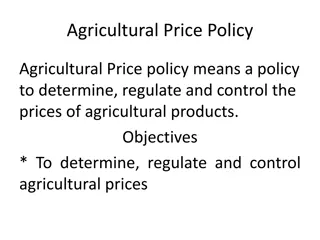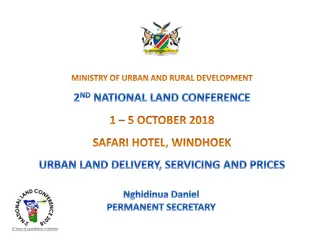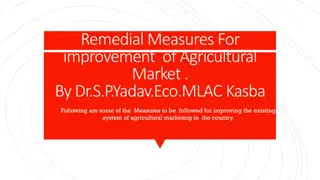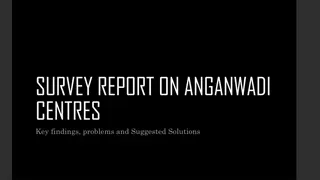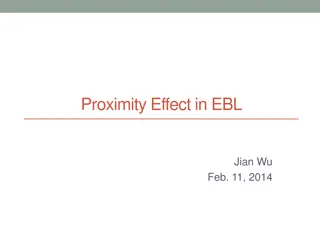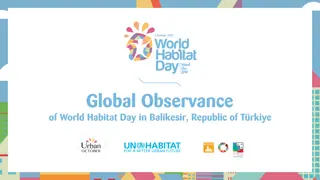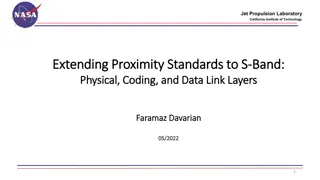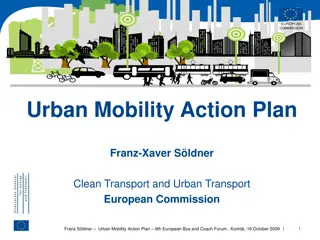Agricultural Transformation and Proximity to Urban Centres: Win-Win Options for Youth in Ethiopia
Rapid urbanization in Africa poses challenges and opportunities for promoting agricultural growth and youth involvement in urban and peri-urban areas. This analysis explores the potential of urban proximity to drive agricultural transformation strategies amid rising youth unemployment concerns.
Uploaded on Feb 23, 2025 | 1 Views
Download Presentation

Please find below an Image/Link to download the presentation.
The content on the website is provided AS IS for your information and personal use only. It may not be sold, licensed, or shared on other websites without obtaining consent from the author.If you encounter any issues during the download, it is possible that the publisher has removed the file from their server.
You are allowed to download the files provided on this website for personal or commercial use, subject to the condition that they are used lawfully. All files are the property of their respective owners.
The content on the website is provided AS IS for your information and personal use only. It may not be sold, licensed, or shared on other websites without obtaining consent from the author.
E N D
Presentation Transcript
Conference on Land Policy in Africa (CLPA) 14-17 November, 2017 . Addis Ababa, Ethiopia. 1 Agricultural transformation and proximity to urban centres: Exploring win-win options for youth involvement in Ethiopia. Tendayi Gondo* and Juliet Akola *Department of Urban and Regional planning, University of Venda, Private Bag X5050, Thohoyandou 0950, Limpopo Province, South Africa: Email tendayi.gondo@univen.ac.za OR gondotee@gmail.com: Tel +27159628583
Introduction 2 Rapid urbanization together with the extraordinary growth of cities has seen half of the world s population residing in urban centers (UNDESA, 2013). With much of this growth expected to occur in urban centers of Africa and Asia (Reviet al., 2014; Taylor and Peter, 2014), cities in these regions face significant adjustment pressures, as poverty becomes increasingly urbanized, demand for urban services swells, and as cities exert greater influence on peri- urban and rural livelihoods and environments (Forster and Escudero, 2014: Padgham et al., 2015). The multiplicity of challenges and uncertainties associated with the growing urban footprint are accentuated by emerging patterns of youth unemployment.
Introduction 3 In Sub-Saharan Africa (SSA) alone, the UN estimates that the number of people living in cities has grown by 160% between 1990 and 2014 and that this number is further expected to triple to 1.3 billion people in 2050 (UN 2014). Youth unemployment is not only a challenge threatening the economic performance of urban centres but a general concern to the overall economic development of the concerned national economies. The burgeoning youthful populations in and around such centres and associated land scarcity issues present a big challenge in promoting growth and agricultural transformation strategies that seek to absorb the youth into the farming business.
Problem Statement 4 The possibility of promoting agricultural growth and transformation development strategies in urban and peri- urban areas (UPA) has seen concerns over food security, income inequalities and youth employment gaining traction in recent years (FAO, 2012; Padgham et al., 2015). UPA resides within the current urban food security and youth unemployment discourse, and where it is viewed by some scholars as an important entry point for addressing both urban food security challenges as well as problems relating to youth unemployment (FAO, 2012; Padgham et al., 2015). Rising urbanization and other territorial attributes characterizing UPA presents various challenges and prospects to achieving agricultural growth and transformation and subsequently the ability of such landscapes to create employment opportunities in the agricultural sector.
Problem Statement 5 While UPA may indeed offer potential to mainstreaming youth involvement in agricultural growth and transformation initiatives associated with the farming business, the knowledge base to support this position and to indicate where conditions are most favourable is quite tenuous. In this analysis we argue that any prospects of mainstreaming youth involvement in agricultural growth and transformation are to a large extent moderated by unique characteristics of different urban and the surrounding rural spaces attributes that we refer to as urban proximity related. Many related studies in this field have often failed fail to employ a multiple criteria based evaluation that depict complex and interrelated attributes that make certain UPA better placed for stimulating youth employment in agro-business. Research and practices associated with youth, agricultural transformation and urban proximity have largely remained uninformed by appropriate territorial studies that recognize the uniqueness of different urban and surrounding rural spaces and their associated variations in urbanization or urbanism induced threats to agricultural growth (Dodman et al., 2017).
Research Objectives 6 With no imminent indications of reverse urbanization / backward migration, questions of where and how actual and aspiring youthful farmers can circumvent agricultural challenges and realize better welfare outcomes need to be addressed. This study specifically sought to;- Evaluate the extent to which the urban settings of 23 Ethiopian cities / towns are conducive to mainstreaming youth involvement in agricultural growth and transformation initiatives associated with UPA.
TERRITORIAL ASSESSMENT INDICATORS Assessment Framework Size of urban market Urban population growth trends Size of the city economy Agglomeration index Regional economic cluster Access to water 7 The analysis first developed an indicator system that defined conduciveness within the context of farm proximity to urban centres. To develop such an indicator system we borrowed insights from literature on agricultural intensification and agricultural transformation as well as associated vulnerability and resilience literature that is often linked to agricultural growth in Quality of agricultural extension services Spatial coverage of agricultural extension services Financial support Chemical fertilizer supply scheme Agricultural growth and transformation capacity Competition for scarce land Environmental planning policy Land-use planning policy Decentralization of planning operations Timeous execution of planning decisions Efficiency of the Land registration process Water management / safety plans URBAN PROXIMTY / AGRICULTURAL GROWTH AND TRANSFORMATION INDEX CATEGORIES ASSESSMENT CONTEXT SOCIO- ECONOMIC INSTITUTIONAL / GOVERNANCE EXPOSURE SENSITIVITY ADAPTIVE CAPACITY Win-Win Win-Lose Lose Win Lose- lose Agricultural innovation Improved seed use Improved irrigation systems Size of land cultivated Agricultural yield Distance to nearest large town Road connectivity Settlement expansion Patterns of urban and peri urban land use Urban land informality. NATURAL / ECOLOGICAL PHYSICAL / ENGINEERING Precipitation Temperature Drainage density Altitude Greenspace Flood risk DIRECT IMPACT UPA. INDIRECT IMPACT Figure 1: The proposed Assessment Framework
Methodology 8 Data Sources: Data on a number of agricultural growth and transformation attributes from was obtained mainly from the Ethiopia s Agricultural Growth Plan (AGPI) baseline, (2011 - 2016), Agricultural Growth Programme Agribusiness Marketing and Development Project (AMDe), Midterm Evaluation Report, February, (2015) and the AGP II, (2017). Where city specific data was not available, averages within the region were used. Data on other important urban proximity, land use planning and environmental planning integrity variables was solicited mainly from Ethiopia s Growth and Transformation Plan II (GTP II) (2015/16-2019/20); State of Ethiopian Cities Report - SECR, (2015); Urban Waste NAMA (Nationally Appropriate Mitigation Actions) - (2016); Central Statistical Agency of Ethiopia, (2013); and the Environmental Policy Update 2012.
Methodology 9 Statistical Procedures: Study site Prior to analysis we assessed our study constructs for homogeneity and dimensionality. Building on Principal Components Analysis (PCA), we then used a hierarchical segmentation based clustering approach to create unique clusters of cities that depicted different welfare outcomes for the youth involvement in farming business. The relative stability of such clusters was assessed through the Kruskall Wallas H one way ANOVA test. The relative importance of the welfare defining indicators which ultimately shaped the identification of what we have referred to as win-win options to youth involvement in agricultural transformation was assessed by a two-step clustering technique.
Homogeneity and Dimensionality 10 Table 2: Reliability and validity analysis Table 1: Principal Components Analysis (PCA) Study Construct Construct Code Number of items Cronbach s alpha (>=0.6) Composite reliability (>=0.6) Average variance extracted (>=0.5) 0.6720 0.7319 0.7356 0.6411 Study variables Component Variable 1 2 3 4 Code Spatial coverage of extension services Chemical fertiliser support scheme Financial support Agricultural growth capacity Competition over scarce land Quality of extension services Improved irrigation Distance to nearest large town Improved seed use Size of land cultivated Agriculture yield Agglomeration index Access to water Size of urban markets Size of city economy Environmental management policy Market potential Water quality management INST1 .960 INST2 .890 Engineering/ physical Socio-economic Institutional Natural / ecological ENG SE INST NAT 5 4 8 4 0.747 0.744 0.747 0.555* 0.911 0.897 0.949 0.876 INST3 .862 -.452 INST4 .717 .678 INST5 -.617 INST6 .557 ENG1 .895 ENG1 .876 ENG3 -.441 .837 ENG4 .740 ENG5 .502 .737 SE1 .885 SE2 .860 SE3 .847 SE4 .711 INST7 .918 INST8 .894 INST9 .422 .833 Extraction Method: Principal Component Analysis. Rotation Method: Varimax with Kaiser Normalization. a. Rotation converged in 7 iterations.
Results 11 Table 3: Number of cities and / or towns occupying each cluster type Bootstrap for Percenta Number of cities / BCa 95% Confidence Std. Error Interval Cluster type towns Valid Percent Cumulative Percent Percent Bias Lower Upper 1 9 39.1 39.1 39.1 .6 9.9 26.1 56.5 2 9 39.1 39.1 78.3 -.6 10.2 21.7 56.5 5 21.7 21.7 100.0 -.1 8.7 8.7 34.8 3 Total 23 100.0 100.0 .0 .0 . . a. Bootstrap results are based on 1000 bootstrap samples Table 4: Pairwise comparison of Clusters base on Kruskal-Wallis Test ANOVA test results The analysis reveals three distinct clusters of urban centres which have varying implications for mainstreaming youth involvement in agricultural growth and transformation. Pair description Standardized Test Statistic ( 2) Cluster a - Cluster b Std. Error Test Statistic P-value Cluster 1 Cluster 2 -9.000 2.985 -4.051 .008 Cluster 1 Cluster 3 -16.000 3.532 -4.530 .000 Cluster 2 Cluster 3 -7000 3.532 -1.982 .047
Results 12 Cluster 1 comprises of Addis Ababa; Dire Dawa; Godar; Bar Hirda; Dessie; Harar; Debre Markos; Debre Birhan; Kombolcha Cluster 2 comprises of Mekelle; Hawassa; Sodo; Arba Minch; Hosana; Adigrat; Adwa; Axum; Dilla Cluster 3 comprises of Adama; Jimma; Shashamane; Bishoftu; Nekemte
Results 13 Relative importance of cluster attributes;- While transformation maintains the general importance of promoting innovations in agricultural infrastructure, inputs, policies, market situation, institutions and technological options (Williams et al., 2000), at a meso-scale level, our analysis has also underscored the value of natural and / ecological factor conditions. existing literature on agricultural growth and A two-step clustering process to predict the relative importance of each predictor variable, revealed a relatively high ranking for ecological factors, followed by socio-economic urban settings, the institutional arrangements and lastly the engineering attributes. With climate change high on the agenda, the high value attached to natural factors such as precipitation, temperature and flood events, should be of serious concern in future agricultural efforts that seek to align agricultural growth plans with employment creation.
Recommendations 14 We recommend that UPAs in close proximity to cluster 1 type cities and / or towns be prioritized for mainstreaming youth involvement on agricultural growth and transformation initiatives as they offer best socio- economic, ecological, and institutional opportunities. There is however scope for improvement on the engineering / physical planning related opportunities particularly with regard to land management system. The second best opportunities are offered by UPAs in close proximity to cluster 2 type cities and / towns. These are however performing better than all other clusters in terms of engineering attributes and in general offer the best opportunities for agricultural growth and transformation from an engineering perspective. Heavy investments in agricultural infrastructure and related inputs in such areas as improved seed and improved irrigation systems are more likely to yield win win options for youth involvement in agriculture when compared to other clusters. The least opportunities are offered by UPAs in close proximity to cluster 3 type cities and / town. Win win scenarios for mainstreaming youth involvement in farming business will require heavy investments on the part of policy makers in areas including, agricultural innovations and associated investments, institutional support mechanisms and associated institutional innovations, market innovations to boost agricultural demand and a host of innovations targeted at making the ecological settings conducive for agro-business.
Thank You! 15 Questions? Comments? Suggestions
